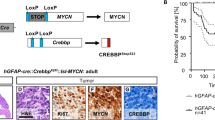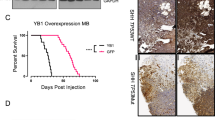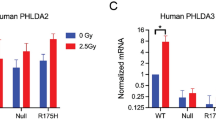Abstract
Hemizygous Ptc1 mice have many features of Gorlin syndrome, including predisposition to medulloblastoma development. Ionizing radiation synergize with Ptc1 mutation to induce medulloblastoma only in neonatally exposed mice. To explore the mechanisms underlying age-dependent susceptibility, we irradiated Ptcneo67/+ mice at postnatal day 1 (P1) or 10 (P10). We observed a dramatic difference in medulloblastoma incidence, which ranged from 81% in the cerebellum irradiated at P1 to 3% in the cerebellum irradiated at P10. A stricking difference was also detected in the frequency of cerebellar preneoplastic lesions (100 versus 14%). Our data also show significantly lower induction of apoptosis in the cerebellum of medulloblastoma-susceptible (P1) compared to -resistant (P10) mice, strongly suggesting that medulloblastoma formation in Ptc1 mutants may be associated with resistance to radiation-induced cell killing. Furthermore, in marked contrast with P10 mice, cerebellum at P1 displays substantially increased activation of the cell survival-promoting Akt/Pkb protein, and markedly decreased p53 levels in response to radiation-induced genotoxic stress. Overall, these results show that developing cerebellar granule neuron precursors' (CGNPs) radiosensitivity to radiation-induced cell death increases with progressing development and inversely correlates with their ability to neoplastically transform.
This is a preview of subscription content, access via your institution
Access options
Subscribe to this journal
Receive 50 print issues and online access
$259.00 per year
only $5.18 per issue
Buy this article
- Purchase on Springer Link
- Instant access to full article PDF
Prices may be subject to local taxes which are calculated during checkout






Similar content being viewed by others

References
Anderson WJ, Stromberg MW . (1977). J Comp Neurol 171: 17–37.
Baldi A, De Luca A, Claudio PP, Baldi F, Giordano GG, Tommasino M et al. (1995). J Cell Biochem 59: 402–408.
Berman DM, Karhadkar SS, Hallahan AR, Pritchard JI, Eberhart CG, Watkins DN et al. (2002). Science 297: 1559–1561.
Blackburn AC, McLary SC, Naeem R, Luszcz J, Stockton DW, Donehower LA et al. (2004). Cancer Res 64: 5140–5147.
Buckbinder L, Talbott R, Velasco-Miguel S, Takenaka I, Faha B, Seizinger BR et al. (1995). Nature 377: 646–649.
Calzada-Wack J, Kappler R, Schnitzbauer U, Richter T, Nathrath M, Rosemann M et al. (2002). Carcinogenesis 23: 727–733.
Cerda H . (1983). Int J Radiat Biol Relat Stud Phys Chem Med 44: 113–121.
Chrysis D, Calikoglu AS, Ye P, D'Ercole AJ . (2001). J Neurosci 21: 1481–1489.
D'Ercole AJ, Ye P, Calikoglu AS, Gutierrez-Ospina G . (1996). Mol Neurobiol 13: 227–255.
Dahmane N, Ruiz-i-Altaba A . (1999). Development 126: 3089–3100.
Dudek H, Datta SR, Franke TF, Birnbaum MJ, Yao R, Cooper GM et al. (1997). Science 275: 661–665.
Enokido Y, Araki T, Tanaka K, Aizawa S, Hatanaka H . (1996). Eur J Neurosci 8: 1812–1821.
Goodrich LV, Milenkovic L, Higgins KM, Scott MP . (1997). Science 277: 1109–1113.
Hahn H, Wojnowski L, Specht K, Kappler R, Calzada-Wack J, Potter D et al. (2000). J Biol Chem 275: 28341–28344.
Hahn H, Wojnowski L, Zimmer AM, Hall J, Miller G, Zimmer A . (1998). Nat Med 4: 619–622.
Hahn H, Wicking C, Zaphiropoulous PG, Gailani MR, Shanley S, Chidambaram A et al. (1996). Cell 85: 841–851.
Herzog KH, Chong MJ, Kapsetaki M, Morgan JI, McKinnon PJ . (1998). Science 280: 1089–1091.
Johnson MD, Xiang H, London S, Kinoshita Y, Knudson M, Mayberg M et al. (1998). J Neurosci Res 54: 721–733.
Lee Y, McKinnon PJ . (2002). Cancer Res 62: 6395–6399.
Linke SP, Sengupta S, Khabie N, Jeffries BA, Buchhop S, Miska S et al. (2003). Cancer Res 63: 2596–2605.
MacDonald TJ, Rood BR, Santi MR, Vezina G, Bingaman K, Cogen PH et al. (2003). Oncologist 8: 174–186.
Mancuso M, Pazzaglia S, Tanori M, Hahn H, Merola P, Rebessi S et al. (2004). Cancer Res 64: 934–941.
Marino S, Vooijs M, van Der Golden H, Jonkers J, Berns A . (2000). Genes Dev 14: 994–1004.
Pazzaglia S, Mancuso M, Atkinson MJ, Tanori M, Rebessi S, Di Majo V et al. (2002). Oncogene 21: 7580–7584.
Raffel C, Jenkins RB, Frederick L, Hebrink D, Alderete B, Fults DW et al. (1997). Cancer Res 57: 842–845.
Raffel C . (2004). Neoplasia 6: 310–322.
Rao G, Pedone CA, Valle LD, Reiss K, Holland EC, Fults DW . (2004). Oncogene 23: 6156–6162.
Saintigny Y, Lopez BS . (2002). Oncogene 21: 488–492.
Sengupta S, Linke SP, Pedeux R, Yang Q, Farnsworth J, Garfield SH et al. (2003). EMBO J 22: 1210–1222.
Singh B, Reddy PG, Goberdhan A, Walsh C, Dao S, Ngai I et al. (2002). Genes Dev 16: 984–993.
Stark JM, Jasin M . (2003). Mol Cell Biol 23: 733–743.
Sturzbecher HW, Donzelmann B, Henning W, Knippschild U, Buchhop S . (1996). EMBO J 15: 1992–2002.
Tong WM, Ohgaki H, Huang H, Granire C, Kleihues P, Wang ZQ . (2003). Am J Pathol 162: 343–352.
Wallace VA . (1999). Curr Biol 9: 445–448.
Wechsler-Reya RJ, Scott MP . (1999). Neuron 22: 103–114.
Wetmore C, Eberhart DE, Curran T . (2000). Cancer Res 60: 2239–2246.
Wetmore C, Eberhart DE, Curran T . (2001). Cancer Res 61: 513–516.
Wood KA, Youle RJ . (1995). J Neurosci 15: 5851–5857.
Ye P, Xing Y, Dai Z, D'Ercole AJ . (1996). Brain Res Dev Brain Res 95: 44–54.
Zindy F, Nilsson LM, Nguyen L, Meunier C, Smeyne RJ, Rehg JE et al. (2003). Cancer Res 63: 5420–5427.
Zurawel RH, Allen C, Chiappa S, Cato W, Biegel J, Cogen P et al. (2000a). Genes Chromosomes Cancer 27: 44–51.
Zurawel RH, Allen C, Wechsler-Reya R, Scott MP, Raffel C . (2000b). Genes Chromosomes Cancer 28: 77–81.
Acknowledgements
We thank Orsio Allegrucci for assistance in handling and treating the mice, and Emanuela Pasquali for excellent technical help. We also thank Vincenzo Cesi for assistance with the experiments shown in Figures 4 and 5. This work was funded in part by a grant from the Commission of European Communities (FI6R-CT-2003-508842 RISC-RAD).
Author information
Authors and Affiliations
Corresponding author
Rights and permissions
About this article
Cite this article
Pazzaglia, S., Tanori, M., Mancuso, M. et al. Linking DNA damage to medulloblastoma tumorigenesis in patched heterozygous knockout mice. Oncogene 25, 1165–1173 (2006). https://doi.org/10.1038/sj.onc.1209032
Received:
Revised:
Accepted:
Published:
Issue Date:
DOI: https://doi.org/10.1038/sj.onc.1209032
Keywords
This article is cited by
-
Three dimensional reconstruction of the mouse cerebellum in Hedgehog-driven medulloblastoma models to identify Norrin-dependent effects on preneoplasia
Communications Biology (2022)
-
Improving Diagnostic and Therapeutic Outcomes in Pediatric Brain Tumors
Molecular Diagnosis & Therapy (2018)
-
Nanog-driven cell-reprogramming and self-renewal maintenance in Ptch1 +/− granule cell precursors after radiation injury
Scientific Reports (2017)
-
Oncogenic YAP promotes radioresistance and genomic instability in medulloblastoma through IGF2-mediated Akt activation
Oncogene (2012)
-
Opposite modifying effects of HR and NHEJ deficiency on cancer risk in Ptc1 heterozygous mouse cerebellum
Oncogene (2011)


